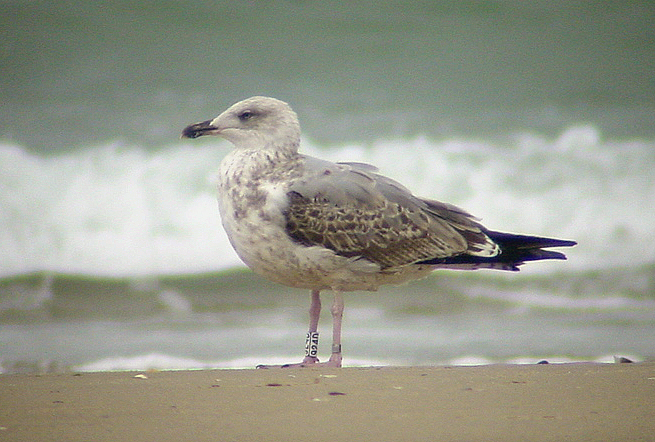 Yellow-legged
Gull - Larus michahellis
Yellow-legged
Gull - Larus michahellis
(last update: October 08 2013)
Coordinators:
Delfín González
Gabriel Martín
Antonio Gutierrez
Amir Ben Dov
Mars Muusse
Yellow-legged Gull michahellis 2CY 924D October 03 2002, Le Portel, France.
Primary P10 is fully grown and all the
secondaries and rectrices are second generation and complete. Hence, the
complete moult has ended. After this complete moult, a partial moult has
included some of the tertials and wing-coverts.
The upper two tertials have been renewed again and the third tertial is
missing. They obviously contrast with the lower tertials, which are
second-generation like in their pattern. Depending on the extend of the post-juvenile moult last year,
those upper tertials may already be fourth generation (many 1CY michahellis include the upper tertials in the post-juvenile moult, as can be seen in
the 1CY michahellis October
Section). An example of such a bird is white ringed 453T.
So, by renewing the upper tertials in autumn in 2CY, those tertials are
fourth generation:
1. juvenile tertials,
2. replaced in the partial post-juvenile moult / first pre-basic moult,
3. replaced in the complete moult in 2CY / second pre-basic moult,
4. replaced in the partial autumn moult in 2CY / third pre-basic-moult
(?).
Although most probably fourth generation, they are not completely adult-like: the upper tertials of 924D again show a 'flame' pattern and an accentuated broad brown shaft-streak. The same is true for the inner two greater coverts. Median covert #1 has been replaced as well and #2 is growing. Lower lesser covert #3 is new as well. Most of the scapulars are plain grey, although some (lower) scapulars show a black shaft-streak. The iris is pale and the base of the bill is pale as well. The legs are pinkish.
This bird hatched and was ringed in southern France, summer 2001.
